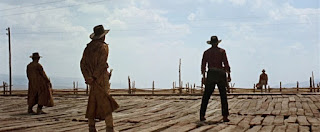Spaghetti westerns were never too progressive in their
depiction of women characters, but Claudia Cardinale’s role at the centre of
Sergio Leone’s epic Once upon a Time in the West is more complex than might
first appear, says Christina Newland.
BFI
By Christina
Newland
April 20, 2018
ountless column inches have been spent in odes to the
voluptuous beauty of Claudia Cardinale. The Italian-Tunisian bombshell was
compared with Bardot, called “‘Italy’s happiest invention” by co-star David
Niven, and became a breakout arthouse star of the 1960s. Her almond-shaped eyes
and feline prettiness undeniably shaped the roles she took on. Cardinale was
the sexy vision of marriageable peasantry in Luchino Visconti’s The Leopard
(1963), the phantom ‘ideal woman’ of Marcello Mastroianni’s dreams in 8½ (1963)
and the well-coiffed princess in The Pink Panther (1964).
Few would assume that Sergio Leone, the lauded but
thoroughly macho director of the Dollars trilogy, would come along and alter
Cardinale’s on-screen depiction as a romanticised but earthy screen goddess.
But the maker of classic spaghetti westerns seems to have met his match with
Cardinale, and her role as the moral force of Once upon a Time in the West
(1968) would prove to be an interesting departure from some of her idealised
previous roles – even if only slightly.
Leone’s arid, dusty epic is set during the waning days of
the American frontier, as an encroaching railroad is set to be constructed over
a valuable tract of land known as Sweetwater. This property is sought after by
the cruel outlaw Frank (Henry Fonda), who cheerfully murders the property’s
rightful owner and unwittingly leaves the man’s widow, Jill McBain (Cardinale),
the sole inheritor of the land.
Threatened on all sides and seemingly helpless to the
vagaries of the violent men around her, Cardinale’s woman refuses to be cowed.
She bravely defends her late husband’s property, even after a brutal implied
rape takes place. When hero Harmonica (Charles Bronson) strides into town to
enact revenge on Frank for separate reasons, he too is drawn to Jill, and
strives to protect her and her land from the sadistic bandit. Finally,
Cheyenne, the local criminal framed for her husband’s murder (Jason Robards),
also circles around the woman, leaving her in a precarious and complex
situation.
On the face of it, it’d be easy to make the argument that Cardinale’s role in the film is not especially progressive. A former prostitute, without the protection or respectability afforded her by her husband, she’s a piece of meat for the taking in Leone’s conception of the old west. It almost goes without saying there are pretty clear limitations on the feminist credentials of most 60s spaghetti westerns. A survey of Clint Eastwood’s oaters of the 70s also reveals some shockingly misogynistic moments, and at the very least a kind of paternalistic gender structure falls into play.
In Once upon a Time in the West, the threat of sexual
violence is nearly omnipresent, which sits on a faintly discomfiting line
between historical reality and artistic licence. For Leone particularly,
questionable depictions of rape dogged him through his career. In his
decade-spanning gangster film Once upon a Time in America (1984), one of the
most disturbing and arguably dramatically unnecessary rape scenes committed to
celluloid takes place. Although a whole article could be devoted to the sexual
politics of that film, it’s evident that Sergio Leone was not forward-thinking
on the subject. As with many directors before and after (from Luchino Visconti
straight through to Abel Ferrara), rape is treated as a motivator for male
protagonists rather than a crime visited on women.
It may be that Cardinale’s imperilled pioneer widow is
empowered only by a matter of degrees, stuck in a dirty and dangerous frontier
that frequently made victims of its more vulnerable inhabitants. But she is the
overruling force at the centre of the narrative, not so much the sole driver of
plot but one whose appraisal of the actions of the violent men around her
matter deeply to the narrative.
It’s through Jill’s eyes that we survey the emptiness of
their machinations, the needless bloodshed at their hands, the greed that Leone
is so intent on underlining. Her affection for Harmonica and for the unfairly
framed Cheyenne (Jason Robards) gives them credence. There is an archetype for a role like this
one, and perhaps in some ways it’s as inflexible as putting her on a
goddess-like pedestal. Leone sees Cardinale in the mold of the woman-as-survivor
– a witness to the cruel deeds of men. But she is also maybe the most
sympathetic character in the film, beset by the predatory motivations of even
the ‘good’ cowboys around her.
This is a woman as idea, symbol, abstraction; not in her
full humanity. But perhaps the entire film is made up of movie myth and
archetype, with its shimmering vistas and riveting close-ups. Once upon a Time
in the West is as much a reflection of cinema past as it is of the historical
frontier.
Cardinale fiercely and defiantly embodies her role,
rolling around in the dirt rather than swanning around in pristine gowns, and
there’s something to be said for it. Perhaps it’s evidence that Leone was
giving thought to the roles and sufferings of women in the grandiose,
death-and-glory landscape of the American west. Perhaps Leone thought about it
more many might give him credit for.












No comments:
Post a Comment